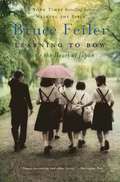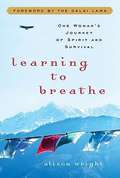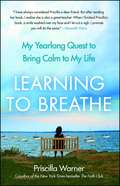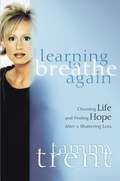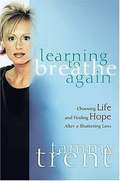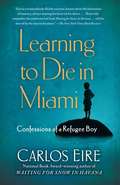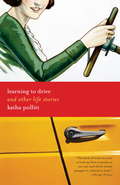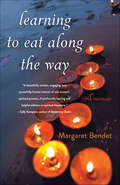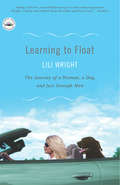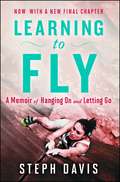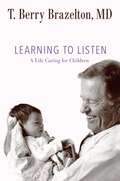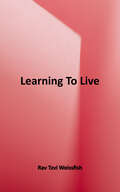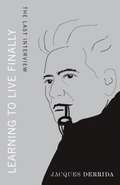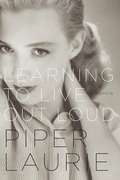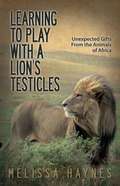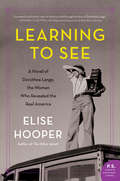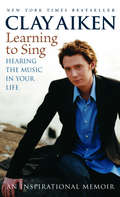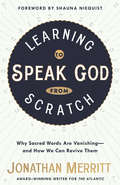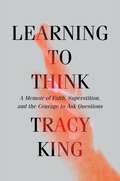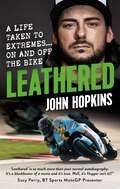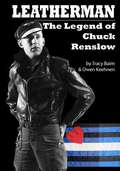- Table View
- List View
Learning to Bow
by Bruce FeilerLearning to Bow has been heralded as one of the funniest, liveliest, and most insightful books ever written about the clash of cultures between America and Japan. With warmth and candor, Bruce Feiler recounts the year he spent as a teacher in a small rural town. Beginning with a ritual outdoor bath and culminating in an all-night trek to the top of Mt. Fuji, Feiler teaches his students about American culture, while they teach him everything from how to properly address an envelope to how to date a Japanese girl.
Learning to Breathe
by Alison WrightAn extraordinary spiritual memoir about the will to survive . . . one breath at a timeWhile traveling in Laos on a winding mountain road, the bus that award-winning journalist Alison Wright was riding in collided with a logging truck. As she waited fourteen hours for proper medical care-in excruciating pain, certain she was moments from death-Alison drew upon years of meditation practice and concentrated on every breath as if it would be her last. Despite countless surgeries and a grueling recovery, Alison set herself the goal of achieving a new dream: to one day climb Mount Kilimanjaro-and she reached the summit on her fortieth birthday. Gasping for air once again, she stood at the highest point in Africa, determined to never again take a single breath for granted. Perfect for readers who love spiritual authors traveling abroad, such as Elizabeth Gilbert (Eat, Pray, Love) and Greg Mortenson (Three Cups of Tea), this memoir is an amazingly inspirational tale of how a life-changing accident transformed one woman's faith. '[A] profound writer . . . a true pilgrim . . . There is muscle and tears here, and the fiercest flame of inspiration. '-Richard Gere
Learning to Breathe
by Priscilla WarnerPriscilla Warner has had a great life: a supportive husband, a flourishing marriage, two loving sons, and a bestselling book, The Faith Club. Despite all her good fortune and success, she suffers from anxiety and panic attacks so debilitating that they leave her unable to breathe. She's tried self-medicating--in high school, with a hidden flask of vodka--and later, with prescription medications--daily doses of Klonopin with a dark-chocolate chaser. After forty years of hyperventilating, and an overwhelming panic attack that's the ultimate wake-up call, Warner's mantra becomes "Neurotic, Heal Thyself." A spirited New Yorker, she sets out to find her inner Tibetan monk by meditating every day, aiming to rewire her brain and her body and mend her frayed nerves. On this winding path from panic to peace, with its hairpin emotional curves and breathtaking drops, she also delves into a wide range of spiritual and alternative health practices, some serious and some . . . not so much. Warner tries spiritual chanting, meditative painting, immersion in a Jewish ritual bath, and quasi-hallucinogenic Ayurvedic oil treatments. She encounters mystical rabbis who teach her Kabbalistic lessons, attends silent retreats with compassionate Buddhist mentors, and gains insights from the spiritual leaders, healers, and therapists she meets. Meditating in malls instead of monasteries, Warner becomes a monk in a minivan and calms down long enough to examine her colorful, sometimes frightening family history in a new light, ultimately making peace with her past. And she receives corroboration that she's healing from a neuroscientist who scans her brain for signs of progress and change. Written with lively wit and humor, Learning to Breathe is a serious attempt to heal from a painful condition. It's also a life raft of compassion and hope for people similarly adrift or secretly fearful, as well as an entertaining and inspiring guidebook for anyone facing daily challenges large and small, anyone who is also longing for a sense of peace, self-acceptance, and understanding.
Learning to Breathe Again: Choosing Life and Finding Hope After a Shattering Loss
by Tammy TrentFollow Christian singer/songwriter Tammy Trent as she tells of her beautiful love story turned tragic, still pointing to God as the source of all life and hope. Theirs was a fairy-tale romance. Her husband, Trent, was Tammy's best friend and business manager. While vacationing in Jamaica in 2001, a routine free diving excursion in the Blue Lagoon turned drastically tragic when Trent never resurfaced. Unfortunately, the following day's events of 9/11 would create an incredible obstacle to Tammy's and her family's efforts to connect and handle these horrendous events. Tearful prayers pleading with God to make Himself real have been answered, and God is slowly restoring Tammy's joy and hope, as she begins to sing and dance again for Him.
Learning to Breathe Again: Choosing life and Finding Hope After a Shattering Loss
by Tammy TrentThis is the story of one young woman who copes with the devastating loss of her best friend and husband. She points to our true help, Jesus Christ.
Learning to Breathe: My Yearlong Quest to Bring Calm to My Life
by Priscilla WarnerPriscilla Warner has had a great life: a supportive husband, a flourishing marriage, two loving sons, and a bestselling book, The Faith Club. Despite all her good fortune and success, she suffers from anxiety and panic attacks so debilitating that they leave her unable to breathe. She's tried self-medicating--in high school, with a hidden flask of vodka--and later, with prescription medications--daily doses of Klonopin with a dark-chocolate chaser. After forty years of hyperventilating, and an overwhelming panic attack that's the ultimate wake-up call, Warner's mantra becomes "Neurotic, Heal Thyself." A spirited New Yorker, she sets out to find her inner Tibetan monk by meditating every day, aiming to rewire her brain and her body and mend her frayed nerves. On this winding path from panic to peace, with its hairpin emotional curves and breathtaking drops, she also delves into a wide range of spiritual and alternative health practices, some serious and some . . . not so much. Warner tries spiritual chanting, meditative painting, immersion in a Jewish ritual bath, and quasi-hallucinogenic Ayurvedic oil treatments. She encounters mystical rabbis who teach her Kabbalistic lessons, attends silent retreats with compassionate Buddhist mentors, and gains insights from the spiritual leaders, healers, and therapists she meets. Meditating in malls instead of monasteries, Warner becomes a monk in a minivan and calms down long enough to examine her colorful, sometimes frightening family history in a new light, ultimately making peace with her past. And she receives corroboration that she's healing from a neuroscientist who scans her brain for signs of progress and change. Written with lively wit and humor, Learning to Breathe is a serious attempt to heal from a painful condition. It's also a life raft of compassion and hope for people similarly adrift or secretly fearful, as well as an entertaining and inspiring guidebook for anyone facing daily challenges large and small, anyone who is also longing for a sense of peace, self-acceptance, and understanding.
Learning to Die in Miami: Confessions of a Refugee Boy
by Carlos EireContinuing the personal saga begun in the National Book Award-winning Waiting for Snow in Havana, the inspiring, sad, funny, bafflingly beautiful story of a boy uprooted by the Cuban Revolution and transplanted to Miami during the years of the Kennedy administration.In his 2003 National Book Award–winning memoir Waiting for Snow in Havana, Carlos Eire narrated his coming of age in Cuba just before and during the Castro revolution. That book literally ends in midair as eleven-year-old Carlos and his older brother leave Havana on an airplane—along with thousands of other children—to begin their new life in Miami in 1962. It would be years before he would see his mother again. He would never again see his beloved father. Learning to Die in Miami opens as the plane lands and Carlos faces, with trepidation and excitement, his new life. He quickly realizes that in order for his new American self to emerge, his Cuban self must &“die.&” And so, with great enterprise and purpose, he begins his journey. We follow Carlos as he adjusts to life in his new home. Faced with learning English, attending American schools, and an uncertain future, young Carlos confronts the age-old immigrant&’s plight: being surrounded by American bounty, but not able to partake right away. The abundance America has to offer excites him and, regardless of how grim his living situation becomes, he eagerly forges ahead with his own personal assimilation program, shedding the vestiges of his old life almost immediately, even changing his name to Charles. Cuba becomes a remote and vague idea in the back of his mind, something he used to know well, but now it &“had ceased to be part of the world.&” But as Carlos comes to grips with his strange surroundings, he must also struggle with everyday issues of growing up. His constant movement between foster homes and the eventual realization that his parents are far away in Cuba bring on an acute awareness that his life has irrevocably changed. Flashing back and forth between past and future, we watch as Carlos balances the divide between his past and present homes and finds his way in this strange new world, one that seems to hold the exhilarating promise of infinite possibilities and one that he will eventually claim as his own. An exorcism and an ode, Learning to Die in Miami is a celebration of renewal—of those times when we&’re certain we have died and then are somehow, miraculously, reborn.
Learning to Drive
by Katha PollittNow a major motion picture starring Patricia Clarkson and Ben Kingsley. Celebrated for her award-winning political columns, criticism, and poetry, Katha Pollitt now shows us another side of her talent. Learning to Drive is a surprising, revealing, and entertaining collection of essays drawn from the author's own life. With deep feeling and sharp insight, Pollitt writes about the death of her father; the sad but noble final days of a leftist study group of which she was a member; and the betrayal and heartbreak inflicted by a man who seriously deceived her. (Her infinitely patient, gentle driving instructor points out her weakness--"Observation, Katha, observation!") She also offers a candid view of her preoccupation with her ex-lover's haunting presence on the Internet, and her search there for a secret link that might provide a revelation about him that will Explain Everything. Other topics include the differences between women and men--"More than half the male members of the Donner party died of cold and starvation, but three quarters of the females survived, saved by that extra layer of fat we spend our lives trying to get rid of"--and the practical implications of political theory: "What if socialism--all that warmhearted folderol about community and solidarity and sharing was just an elaborate con job, a way for men to avoid supporting their kids?" Learning to Drive demonstrates that while Katha Pollitt is undeniably one of our era's most profound observers of culture, society, and politics, she is just as impressively a wise, graceful, and honest observer of her own and others' human nature.
Learning to Eat Along the Way: A Memoir
by Margaret BendetWhen Margaret Bendet is told to interview an Indian holy man, she thinks it’s just another assignment—but after speaking with him, she decides to accompany him back to his ashram, hoping to find enlightenment. In Learning to Eat Along the Way, Bendet enters a world that many have wondered about but few have seen: the milieu of a spiritual master. Subtle experiences prompt her to embark on this journey with “the swami,” as she calls the holy man, and to enter into the ashram—but once there, she deals with a host of psychological issues, including intense infatuation and life-threatening anorexia. “Each person comes to the ashram in order to receive something,” the swami tells her, “something to take with you when you leave—something you can eat along the way.” Bendet finds this to be truer than she could have imagined. Clear-eyed and candid, Learning to Eat Along the Way is an honest and often surprising account of one woman’s experience with spiritual work.
Learning to Float: The Journey of a Woman, a Dog, and Just Enough Men
by Lili WrightLili Wright is a thirty-something woman on the emotional lam. Faced with a choice between two men--Stuart, the steady veterinarian, and Peter, the dreamy writer--she climbs into her car and leaves them both behind.With only a borrowed dog named Brando for company and a map of twelve states in her pocket, Lili sets out on a road trip, hoping that by setting herself in motion she will find a way to settle down. Charting a course from Cadillac Mountain in Maine to the faded glory of Key West, Florida, she camps out on beaches and crashes on couches, in sketchy motels and even in a cop's trailer. She travels not only south, but also back in time, trying to figure out why previous relationships with a Nantucket waiter, a French tennis clown, a Utah ski bum, and others flared and fizzled.Along the way, Lili meets a string of unlikely gurus, including a well-worn shrimper, a vegan astrologer, and even a woman who marries herself. These and other unassuming strangers offer offbeat wisdom and guidance as Lili struggles to understand the nature of love, the voodoo of sex, and how couples can settle down without settling for. Between adventures, Lili tackles tough questions: Why does everything love touches turn risky? Does staying with the same person mean staying the same? Where does love come from, and where does it go? By journey’s end, this restless traveler begins to see how she can share her life with just one other person, and how love, like water, can make a body float.Lili Wright’s engaging memoir from the road updates the tradition of the picaresque traveler’s tale. With unflinching honesty and refreshing wit, she captures the torn emotions, comic misfires, and inevitable trade-offs felt by young people everywhere.
Learning to Fly: An Uncommon Memoir of Human Flight, Unexpected Love, and One Amazing Dog
by Steph DavisWITH A NEW EPILOGUE BY THE AUTHOR World-class free climber Steph Davis delivers a &“thrilling and infectiously interesting&” (San Francisco Book Review) memoir about rediscovering herself through love, loss, and the joy of letting go. The paperback includes a new epilogue in which Davis shares how her husband Mario&’s tragic accident has affected her relationship to climbing and flying.Steph Davis is a superstar in the climbing community and has ascended some of the world’s most challenging and awe-inspiring peaks. But after her first husband makes a controversial climb in a national park, the media fallout escalates rapidly and in one fell swoop leaves her without a partner, a career, a source of income...or a purpose. In the company of only her beloved dog, Fletch, Davis sets off on a search for a new identity and discovers skydiving. Falling out of an airplane is completely antithetical to the climber’s control she’d practiced for so long, but she perseveres, turning each daring jump into an opportunity to fly, first as a skydiver, then as a base jumper. As she opens herself to falling, she also finds the strength to open herself to love again, even in the wake of heartbreak. And before too long, she meets someone who shares her passion for living life to the limit. With gorgeous black-and-white photos throughout, Learning to Fly is Davis’s fascinating account of her transformation. From her early tentative skydives, to zipping into her first wingsuit, to surviving devastating accidents against the background of breathtaking cliffs, to soaring beyond her past limits, she discovers new hope and joy in letting go.
Learning to Listen: A Life Caring for Children (A Merloyd Lawrence Book)
by T. Berry BrazeltonFrom his childhood in Waco, Texas, where he took expert care of nine small cousins while the adults ate Sunday lunch, to Princeton and an offer from Broadway, to medical and psychoanalytic training, to the exquisite observations into newborn behavior that led babies to be seen in an entirely new light, Dr. T. Berry Brazelton's life has been one of innovation and caring. Known internationally for the Touchpoints theory of regression and growth in infants and young children, Brazelton is also credited for bringing the insights of child development into pediatrics, and for his powerful advocacy in Congress. In Learning to Listen, fans of Brazelton and professionals in his field can follow both the roots of a brilliant career and the evolution of child-rearing into the twenty-first century.
Learning to Live
by Harav Tzvi WeissfishSo much more than a biography, this book draws you into the holy life and treasured teachings of Maran Harav Elyashiv, zt"l as no other title can. With over 650 soul-stirring pages of firsthand accounts, profound insights, powerful messages, hanhagos, anecdotes, stories, and life lessons, this is truly a sefer kodesh to savor and cherish. <p><p>For over 30 years, the author, Harav Tzvi Weissfish, basked in the presence of Harav Eliyashiv, keeping a meticulous journal of all he learned and experienced. Add to that dozens of interviews with immediate family and close talmidim, and what emerges is an unforgettable mussar sefer of breathtaking scope. Tens of thousands of the Hebrew edition, Gedolah Shimushah, have already motivated and uplifted the lives of readers worldwide, and now this English edition is ready to transform your life as well.
Learning to Live Finally: The Last Interview
by Jacques Derrida Jean Birnbaum Pascal-Anne BraultWith death looming, Jacques Derrida, the world's most famous philosopher--known as the father of "deconstruction"--sat down with journalist Jean Birnbaum of the French daily Le Monde. They revisited his life's work and his impending death in a long, surprisingly accessible, and moving final interview. Sometimes called "obscure" and branded "abstruse" by his critics, the Derrida found in this book is open and engaging, reflecting on a long career challenging important tenets of European philosophy from Plato to Marx. The contemporary meaning of Derrida's work is also examined, including a discussion of his many political activities. But, as Derrida says, "To philosophize is to learn to die"; as such, this philosophical discussion turns to the realities of his imminent death--including life with a fatal cancer. In the end, this interview remains a touching final look at a long and distinguished career.
Learning to Live Out Loud: A Memoir
by Piper LaurieAn intimate memoir by three-time Oscar nominee Piper Laurie, one of Hollywood's most gifted and respected actressesAt the age of seventeen, in the glory days of movie-making, Piper Laurie was living every little girl's dream. Having been selected by Universal Studios to be a contract star, Piper was removed from her acting class and provided with stylists, chaperones, leading roles, and handsome dates, and elevated to the heights of Hollywood. Her beauty was admired by the likes of Ronald Reagan, Howard Hughes, Paul Newman, Tony Curtis, as well as dozens of directors and legions of fans. Her name was emblazoned on marquees across America for hit movies of the fifties such as the The Prince Who Was a Thief, The Mississippi Gambler, and Ain't Misbehavin'. But Piper discovered early on that the little girl's dream was not her own. Mortified by the shallowness of the roles and movies she was given, she longed for the freedom and fulfillment of her own artistic vision. After years in the studio system, shy Piper Laurie found her voice and the courage to burn her contract. It was only after she left the oppressive studio culture that she began to star in the TV shows, plays, and films that truly became the hallmarks of her career: The Glass Menagerie on Broadway, the original Days of Wine and Roses, The Hustler, the iconic Carrie, and Twin Peaks. She grew into a three-time Oscar-nominated actress, an accomplished sculptor, and a director. This memoir is the inspiring tale of Piper's perseverance to break from tradition and to practice her craft at the highest level. She started life as a withdrawn, mute child who couldn't find her voice and was transformed into a woman who learned to live out loud by her own rules.From the Hardcover edition.
Learning to Play With a Lion's Testicles
by Melissa HaynesThe cheeky title of Melissa Haynes's story of adventure in Africa, Learning to Play with a Lion's Testicles, earned the book some big publicity on NBC-TV/Late Night with Jimmy Fallon on September 4,2013 where it topped the show's list of "Titles Not to Read" for September 2013. Melissa's book was also a big smash on the March 11, 2014 Ellen Show, where Ellen and guest Ricky Gervais highlighted the book throughout the entire hour. Playing with a lion's testicles: An African saying that means to take foolhardy chances.Melissa, an exhausted executive from the city seeks meaning and purpose from her work, and volunteers for a Big Five conservation project in South Africa. Her boss, an over-zealous ranger, nicknamed the Drill Sergeant, has no patience for city folk, especially if they're women, and tries to send her packing on day one. But Melissa stands her ground with grit and determination, however shaky it may be.Conflict soon sets the pace with a cast filled with predatory cats, violent elephants, and an on-going battle of wits with the Drill Sergeant. Even Mother Nature pounds the reserve with the worst storm in a century. But the most enduring and profound conflict is the internal battle going on within Melissa, as she tries to come to terms with the guilt surrounding her mother's death. When death grips the game reserve, it is the very animals Melissa has come to save that end up saving her.For the reader who has ever dreamed of going to Africa or knows the pain of loss and guilt, LEARNING TO PLAY WITH A LION'S TESTICLES will fill your soul.
Learning to See: A Novel of Dorothea Lange, the Woman Who Revealed the Real America
by Elise Hooper“A fascinating and sometimes surprising” biographical novel of “a woman known for her iconic photographs but not her eventful life” (Library Journal).In 1918, a fearless twenty-two-year old arrives in bohemian San Francisco from the Northeast, determined to make her own way as an independent woman. Renaming herself Dorothea Lange she is soon the celebrated owner of the city’s most prestigious and stylish portrait studio and wife of the talented but volatile painter, Maynard Dixon.By the early 1930s, as the America’s economy collapses, her marriage founders and Dorothea must find ways to support her two young sons single-handedly. Determined to expose the horrific conditions of the nation’s poor, she takes to the road with her camera, creating images that inspire, reform, and define the era. And when the United States enters World War II, Dorothea chooses to confront another injustice—the incarceration of thousands of innocent Japanese Americans.At a time when women were supposed to keep the home fires burning, Dorothea Lange, creator of the most iconic photographs of the 20th century, dared to be different. But her choices came at a steep price . . .
Learning to Sing
by Clay AikenIn Learning to Sing, Clay Aiken tells the story of how his faith was integral to him learning valuable life lessons during his meteoric rise from life as an aspiring educator in Raleigh, North Carolina to instant stardom on "American Idol." Clay's advice is 1) Believe in yourself, 2) Believe in God, and 3) Be really stubborn. This personal relationship with God is key to personal success, as Clay has witnessed in real life experiences. When asked to "dirty up" his lyrics to increase sales, he resisted-and has sold more than 3 million albums. He refuses to make videos placing him in inappropriate situations, and considers his relationship with God the most valuable in his life. Learning to Sing is an account of Clay Aiken's extraordinary faith and will and perseverance, and an inspiring memoir by someone who became-against all odds-one of the biggest pop stars of his time.
Learning to Sing: Hearing the Music in Your Life: An Inspirational Memoir
by Clay AikenIn Learning to Sing, Clay Aiken tells the story of how his faith was integral to him learning valuable life lessons during his meteoric rise from life as an aspiring educator in Raleigh, North Carolina to instant stardom on "American Idol. " Clay's advice is 1) Believe in yourself, 2) Believe in God, and 3) Be really stubborn. This personal relationship with God is key to personal success, as Clay has witnessed in real life experiences. When asked to "dirty up" his lyrics to increase sales, he resisted -- and has sold more than 3 million albums. He refuses to make videos placing him in inappropriate situations, and considers his relationship with God the most valuable in his life. Learning to Sing is an account of Clay Aiken's extraordinary faith and will and perseverance, and an inspiring memoir by someone who became -- against all odds -- one of the biggest pop stars of his time.
Learning to Speak God from Scratch: Why Sacred Words Are Vanishing--and How We Can Revive Them
by Jonathan Merritt Shauna NiequistIn a rapidly changing culture, many of us struggle to talk about faith. We can no longer assume our friends understand words such as grace or gospel. Others, like lost and sin, have become so negative they are nearly conversation-enders. Jonathan Merritt knows this frustration well. After moving from the Bible Belt to New York City, he discovered that the sacred terms he used to describe his spiritual life didn’t connect as they had in the past. This launched him into an exploration of an increasing American reluctance to talk about faith—and the data he uncovered revealed a quiet crisis of affecting millions. In this groundbreaking book, Jonathan revives ancient expressions through incisive cultural commentary, vulnerable personal narratives, and surprising biblical insights. Both provocative and liberating, Learning to Speak God from Scratch will breathe new life into your spiritual conversations and invite you into the embrace of the God who inhabits them.
Learning to Think: A Memoir of Faith, Superstition, and the Courage to Ask Questions
by Tracy KingSet in 1980s Birmingham, England, a piercing memoir about the liberating power of a scientific view of the world. Tracy King was raised in a house of contradictions—her family was happy and creative, yet shadowed by debt, phobias, her father’s alcoholism, and the illusory promises of a born-again Christian church. The uneasy balance of the King household was irrevocably upended on a rainy spring night in 1988, when her father was killed by teenagers just blocks from their public housing estate. Her mother’s dysfunctional reliance on the church deepened following the tragedy, and King, suffering from undiagnosed anxiety, stopped attending school. The account of her father’s death remained hazy, made worse by the fact that four of the accused teenagers—neighborhood boys she could not avoid—were never charged. What could have triggered such an act of aggression? Clinging to hearsay and what little information she had from the police, King allowed her imagination to fill in the rest. Over the years, in a bid to balm her grief and gaps in formal education, King journeyed through multiple belief systems: she distanced herself from fundamentalism, searching for clarity instead in the occult, paranormal beliefs, and conspiracy theories. Amid the chaos of her coming of age, she stumbled upon a copy of Carl Sagan’s The Demon-Haunted World on the shelves of a Birmingham bookshop —a discovery that proved transformative. Sagan’s sage caveat, “But I could be wrong,” became King’s guiding light, empowering her to confront her demons. An eloquently written and often sharply funny account that is ever sensitive to the fallibility of memory and the nuances of truth, Learning to Think is a resounding battle cry for the value of education and the freedom to think critically, imaginatively, and for oneself.
Leathered: A life taken to extremes... on and off the bike
by John HopkinsInjury. Adrenaline. Addiction. These are the things that fuelled one man's race to international stardom as he pushed boundaries and took life on and off the bike to the limits.Starting out as a talented youth riding the desert tracks of California, his reckless nature and incredible talent earned him a position in the rarefied world of professional motorcycle racing. Despite the success in his professional life, his personal life was crumbling around him - John was battling with depression and temptation, which began to threaten his career, health and marriage, ultimately bringing him to a life of alcoholism, addiction and even smuggling. In his remarkable memoir, one of the world's most renowned riders takes us on a raw and unique journey to the extremes of fast living.John 'Hopper' Hopkins is an icon for motorsport fans worldwide. He won't let anything hold him back. He has broken almost every bone in his body (twice), suffered a bleed on the brain, and had a finger amputated... yet he continued to race. Finally, at the age of 35 - with his latest crash at Brands Hatch in 2017 putting him in rehab for two years - he decided to hang up his helmet.Leathered tells the incredible story of an unparalleled career. From bone-crunching injuries and alcohol-fuelled antics to the breakdown of his marriage, it unveils the true stories behind the lurid headlines.(P)Octopus Publishing Group 2021
Leathered: A life taken to extremes... on and off the bike
by John HopkinsInjury. Adrenaline. Addiction. These are the things that fuelled one man's race to international stardom as he pushed boundaries and took life on and off the bike to the limits.Starting out as a talented youth riding the desert tracks of California, his reckless nature and incredible talent earned him a position in the rarefied world of professional motorcycle racing. Despite the success in his professional life, his personal life was crumbling around him - John was battling with depression and temptation, which began to threaten his career, health and marriage, ultimately bringing him to a life of alcoholism, addiction and even smuggling. In his remarkable memoir, one of the world's most renowned riders takes us on a raw and unique journey to the extremes of fast living.John 'Hopper' Hopkins is an icon for motorsport fans worldwide. He won't let anything hold him back. He has broken almost every bone in his body (twice), suffered a bleed on the brain, and had a finger amputated... yet he continued to race. Finally, at the age of 35 - with his latest crash at Brands Hatch in 2017 putting him in rehab for two years - he decided to hang up his helmet.Leathered tells the incredible story of an unparalleled career. From bone-crunching injuries and alcohol-fuelled antics to the breakdown of his marriage, it unveils the true stories behind the lurid headlines.
Leathered: A life taken to extremes... on and off the bike
by John HopkinsInjury. Adrenaline. Addiction. These are the things that fuelled one man's race to international stardom as he pushed boundaries and took life on and off the bike to the limits.Starting out as a talented youth riding the desert tracks of California, his reckless nature and incredible talent earned him a position in the rarefied world of professional motorcycle racing. Despite the success in his professional life, his personal life was crumbling around him - John was battling with depression and temptation, which began to threaten his career, health and marriage, ultimately bringing him to a life of alcoholism, addiction and even smuggling. In his remarkable memoir, one of the world's most renowned riders takes us on a raw and unique journey to the extremes of fast living.John 'Hopper' Hopkins is an icon for motorsport fans worldwide. He won't let anything hold him back. He has broken almost every bone in his body (twice), suffered a bleed on the brain, and had a finger amputated... yet he continued to race. Finally, at the age of 35 - with his latest crash at Brands Hatch in 2017 putting him in rehab for two years - he decided to hang up his helmet.Leathered tells the incredible story of an unparalleled career. From bone-crunching injuries and alcohol-fuelled antics to the breakdown of his marriage, it unveils the true stories behind the lurid headlines.
Leatherman: The Legend of Chuck Renslow
by Tracy Baim Owen KeehnenA prominent Chicago gay activist and entrepreneur is the subject of an in-depth biography, Leatherman: The Legend of Chuck Renslow, by journalists and authors Tracy Baim and Owen Keehnen. Living as an openly gay man in 1950s Chicago was no easy task. For Chuck Renslow, that was only his first of many bold moves. Just out of high school he began what was to become a six-decade empire, starting more than two dozen businesses in Chicago, as well as a few in other cities. He has owned bars, discos, photo studios, health clubs, bathhouses, gay magazines and newspapers, hotels, restaurants, and bookstores. Throughout it all he dealt with Mafia and police payoffs, anti-gay political policies, harassment from censors, and even controversy within the gay community. In the mid-1950s, after having a portrait and then cheesecake studio, Renslow began experimenting with beefcake photography and began Kris Studio. With his longtime lover, the artist Dom Orejudos aka Etienne and Stephen, at his side, Renslow created Kris Studio a leader in male physique photography, resulting in such magazines as Triumph, Mars and The Rawhide Male, producing thousands of erotic images as well as several films. In 1959 Renslow took over the Gold Coast Show Lounge and transformed it into one of the most lowdown libidinous gay leather bars in the world. With Etienne's murals adorning the walls, a leather/Western/uniform dress code for patrons, and a dark Pit that featured all sorts of goings-on, the Gold Coast set the standard for raunchy kink and gay sexual liberation. It was the birthplace of motorcycle clubs and sex groups, but above all a place for people to meet, connect, and explore themselves and their sexuality. The Gold Coast was also the birthplace of the first leather contest, which in the span of a few short years evolved beyond the bar's capacity and became International Mr. Leather in 1979. More than three decades later, it continues to be one of the world's most popular gay events. Renslow was also one of the pioneers in taking a bathhouse beyond merely the borders of a mere sex club. Man's Country became something truly unforgettable in the 1970s - a sex-and-entertainment complex with a variety of rooms, shops, and a Music Hall that attracted top names touring in the "K-Y circuit," from Sally Rand to Wayland Flowers to Rusty Warren and Charles Pierce. Renslow was a dynamic force in Chicago politics under mayors starting with Richard J. Daley, and he ran to be a delegate for Sen. Ted Kennedy's 1980 presidential run. He danced with another man at a 1977 inaugural ball for Jimmy Carter. Renslow helped protest against unfair policies, fought censorship and entrapment, and battled Anita Bryant. He even served as a field contact for the pioneering work at the Kinsey Institute, as well as performing sexual acts for Kinsey researchers. He knew entertainment celebrities from Marlene Dietrich to Rudolf Nureyev, from Divine to Grace Jones, and from Sylvester to Quentin Crisp. In their heyday Chuck Renslow's annual White Parties were celebrations beyond compare. When Chicago's gay community faced the loss of its newspaper, Renslow bailed out and ran GayLife. He also co-founded the Leather Archives & Museum (with Tony DeBlase). Through it all Renslow has also been Daddy of the Family, a unique created group of lovers, tricks, and friends who were bound by sex and oftentimes love and by a goal of providing comfort and support to one another.
